We founded BondSavvy in 2017 to make bond investing easy and
more profitable for individual investors.
While we have narrowed down the corporate bond universe from 9,000
available bonds to a list of 52 recommended corporate bonds for BondSavvy
subscribers, we receive questions as to how subscribers should allocate
investments across our recommendations.
Since BondSavvy does not provide individualized advice, we
cannot tell each subscriber how to allocate our bond recommendations across an
entire investment portfolio. That said,
we can provide considerations and our ten "How To Build a Bond Portfolio" dos and don'ts
for BondSavvy
subscribers to consider.
These include the following:
How To Build a Bond Portfolio: Ten Dos and Don'ts
- Do build your bond portfolio over time
- Do use bond price volatility to your advantage, when appropriate
- Do consider what's in your non-bond portfolio
- Do consider 'value' available in the marketplace when deciding how much to invest at a given time
- Don't build bond ladders
- Do diversify across industry groups
- Do invest in investment grade and high yield corporate bonds
- Do diversify across maturity dates
- Don't feel compelled to purchase bonds in large quantities
- Don't think cash and corporate bonds have the same level of security
Fixed Income Blog Post Overview
This fixed income blog post addresses “How To Build a Bond
Portfolio” and is primarily geared toward BondSavvy subscribers who have access
to our corporate bond recommendations. Since BondSavvy only recommends individual
corporate bonds, these investments will be the focus of this article. Please read our corporate bonds advantages and disadvantages blog
post, which can help you decide whether you should
consider adding a greater exposure to corporate bonds in your investment
portfolio.
Since this fixed income blog post is geared toward BondSavvy
subscribers, it does not start from square one on how to select compelling corporate
bond investments. Please read our corporate bond research blog post to learn the
factors we evaluate before
recommending bonds to BondSavvy subscribers.
This Article's Recommendations Are Not Individualized Advice
Readers of this fixed income blog post will come from all
walks of life. They will have different
investment objectives, incomes, amounts to invest, time horizons, etc. Given this, the recommendations herein
are
not individualized advice but rather represent what we believe to be sound
practices when building a corporate bond investment portfolio.
We founded BondSavvy to empower the individual investor. We provide a significant amount of
information regarding our bond recommendations and our approach to bond
investing. In the end, however, it is
the BondSavvy subscriber who makes the final call on what bonds go into their investment portfolios.
How Many Bonds Should I Own?
A popular question posed by BondSavvy subscribers is “How
many different bonds should I own?” As we discuss
in this fixed income blog post, we do recommend new bond investors start small
and build their portfolios over time. A
new bond investor could begin with investments across several different bonds
and build the portfolio over time. This section considers what a fully built-out bond portfolio could look
like.
No magic number of bonds
As of February 24, 2023, BondSavvy recommended 52 individual
corporate bond CUSIPs as buy or hold. At the
time, this was the largest number of bonds on our recommended list since
BondSavvy's founding in 2017. This
resulted, in part, to the weak performance of the 2022 bond market and limited
opportunities to sell at compelling prices.
Since investors will have different holdings in their
non-bond portfolios, different risk profiles, and different corporate bond
holdings, there is not a “perfect” number of BondSavvy recommendations to
own. That said, we can provide general guidance as to the number of BondSavvy recommendations subscribers
could hold based on certain factors.
Figure 1 is not meant to be prescriptive and is not individualized advice. Rather, it seeks
to provide a range of the quantities of bond CUSIPs subscribers may choose to own based on the risk of the corporate
bond and non-bond holdings. There are many caveats to this, including the importance of following the "How To
Build a Bond Portfolio" dos and don'ts discussed in this fixed income blog post.
Figure 1: Potential Number of Bond Holdings Based on Portfolio Risk
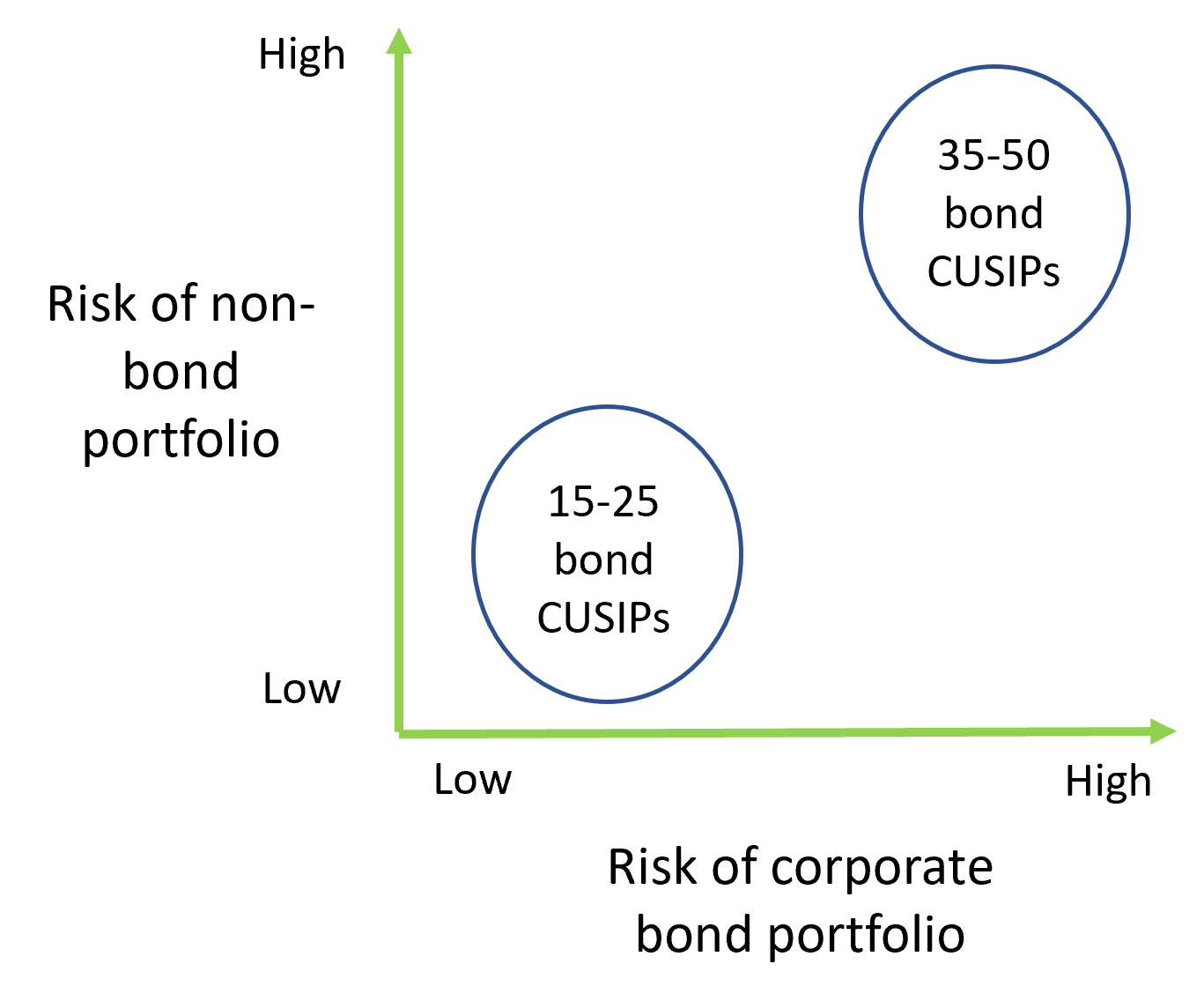
Figure 1's underlying premise is that investors with higher-risk portfolios should consider owning
a wider variety of bonds. We recommend investors who have higher-risk non-bond portfolios and
higher-risk corporate bond portfolios own between 35-50 different corporate bond CUSIPs. Those with
lower-risk portfolios could consider owning a smaller number of bond CUSIPs; however, this will depend on investors'
risk tolerance and investment objectives.
Example of Low-Risk Non-Bond Portfolio
Investors with 'low-risk non-bond portfolios' would likely have a significant amount held in
cash. These investors are generally risk averse. Such an investor may not need to own more than 15-25
BondSavvy recommendations provided he was investing in our lower-risk recommendations. Owning a lower number
of recommended bonds can increase portfolio volatility; however, it can also help drive higher long-term
performance assuming no investments incur permanent capital loss.
Own Different Types of Bonds
In Figure 1, we provide general guidelines on the number of BondSavvy recommendations subscribers
may choose to own based on certain factors such as the risk level of their corporate bond and non-bond
holdings. It's important to keep in mind, however, that accomplishing diversification in corporate bonds is
not just a question of owning a certain quantity of bonds. Rather, we believe investors should consider owning
a variety of bonds as they build their portfolios.
For example, since investment grade corporate bonds can be highly sensitive to US Treasury yields,
a portfolio with 30 corporate bonds that were all investment grade would not necessarily be a well-diversified
portfolio. As we saw in 2022, investment grade corporate bonds -- both long- and short-dated -- had some of
the worst bond performance due to their sensitivity to US Treasury yields.
As we discuss later in this fixed income blog post, we believe it's important for BondSavvy
subscribers to own both investment grade and high yield corporate bonds since their price movements are
generally driven by different factors. Please read our corporate bond credit spreads blog post for a more
comprehensive discussion on key drivers of investment grade and high yield corporate bond prices.
Must Still Follow the Other Rules
The number of bond CUSIPs BondSavvy subscribers may choose to own should not be considered in a
vacuum. Rather, investors must consider the quantity of bond CUSIPs they choose to own with the other
considerations discussed in this "How To Build a Bond Portfolio" article.
How To Build a Bond Portfolio: The Dos and Don'ts Explained
Recommendation 1: Do Build Your Bond Portfolio
over
Time
Many BondSavvy subscribers are investing in individual
corporate bonds for the first time.
Building a bond portfolio over time is important for all investors, but
it is especially important for those new to bond investing.
It's okay to start small
Many investors will ask, “How much should I invest in bonds
to get started?” Some financial
advisors will respond to this
question with a gargantuan sum.
Do NOT listen to these folks.
We believe new bond investors should start small, as individual
corporate bonds are new territory for many investors. Investing mistakes can happen, and such
mistakes can be more common for new investors.
It's better for these mistakes to be made with a small-to-start amount
invested.
A key advantage to owning individual bonds vs. bond funds is
that, over time, individual bond investors should learn and improve. They will learn how and why different
bonds
can react to different market conditions.
They will learn from bond investments that performed well and others that did
not. They will better understand how to
use online brokerages such as Fidelity, E*TRADE, and others.
It is with this knowledge that investors could, potentially,
increase their exposure to individual corporate bonds over time.
BondSavvy founder and fixed income expert Steve Shaw's first
investment in corporate bonds was one CUSIP where he purchased a quantity of
five bonds. As he had success investing
in corporate bonds, he increased his exposure to individual corporate bonds
until the point where it represented his entire investment portfolio.
Limit the risk of going 'all-in' at a bad time
The year 2021 was generally a good year for bond
investing. US Treasury yields did rise
slightly; however, bond defaults were minimal, and many bonds performed well.
While this seemed like a good time to invest, given 2022 was
one of the worst years in the history of the bond market, those who invested
heavily in 2021 would have likely seen their portfolios take a big hit in 2022. In addition, investors who
were 'fully
invested' in 2021 likely had limited resources available to take advantage of
bond prices that fell in 2022.
Figure 2: BondSavvy Recommends Bond Investors NOT Go All-in at a Specific Time

Rome wasn't built in a day, and we believe successful bond
portfolios should be built over time, in part, to limit risk.
Take advantage of new opportunities as they arise
BondSavvy makes new corporate bond recommendations each
quarter after companies report quarterly earnings. We do this during The Bondcast, an
interactive webcast series where fixed income expert Steve Shaw reviews
the investment rationale and financial analysis for each bond recommendation. We also update each bond
recommendation every
quarter with new buy/sell/hold ratings during The Super Bondcast.
We originally published this fixed income blog post in
February 2023. This followed one of the
worst years in the bond market of all time.
During 2022, the US Federal Reserve increased the federal funds target rate
from 0.00% to 0.25% to 4.25% to 4.50%.
For most of the year, US Treasury yields, which have can have a big
impact on certain corporate bonds, increased. Later in this article, we will show examples of how different
corporate bonds behaved differently in the wake of high inflation and a hawkish US Federal Reserve.
While 2022 was one to forget for many bond investors, those
who left some money on the sidelines were able to purchase many corporate bonds
at all-time lows. These included bonds
of some of the world's most profitable companies that, at the publication of
this fixed income blog post, were trading around 60 cents on the dollar. While these bonds may not return to
par in
the next 12-18 months, if they return to par over, say, three years, this will
represent an outstanding return given the very low risk of default of
investment grade corporate bonds
Recommendation 2: Do Use Bond Price Volatility to
Your Advantage, When Appropriate
One of the key advantages of corporate
bonds vs. stocks and bond funds is that, so long as a bond issuer
doesn't go belly up, corporate bond prices are required to return to par value at maturity. Bond funds and stocks don't trade relative to par value and
neither provide a guarantee to return to any price in the future.
Individual bondholders can use this to their advantage to navigate bond price
volatility. Some of the most volatile bonds in the marketplace are long-term investment grade corporate
bonds such as the Apple 2.95% '49 bond (CUSIP 037833DQ0). Figure 3 shows the price action of this Apple
bond from September 4, 2019 until February 24, 2023. As discussed in our credit spreads
blog post, investment grade corporate bonds can be highly sensitive to movements in US Treasury yields.
This is especially true for long-dated investment grade corporate bonds such as the Apple '49 bond.
As shown in Figure 3, this Apple bond fell 52 points from its peak on July 23, 2020
to its low on October 24, 2022. Since Apple has a close to zero risk of default, investors can purchase
these bonds at a deep discount to par value, collect their coupons, and wait for the Apple bond price to
recover. While we do not have a crystal ball as to when these bonds may return to par value, it's likely
they will do so well before the 2049 maturity date.
Figure 3: Performance of Apple 2.95% 9/11/49 Bond -- Sep
4, 2019-Feb 24, 2023
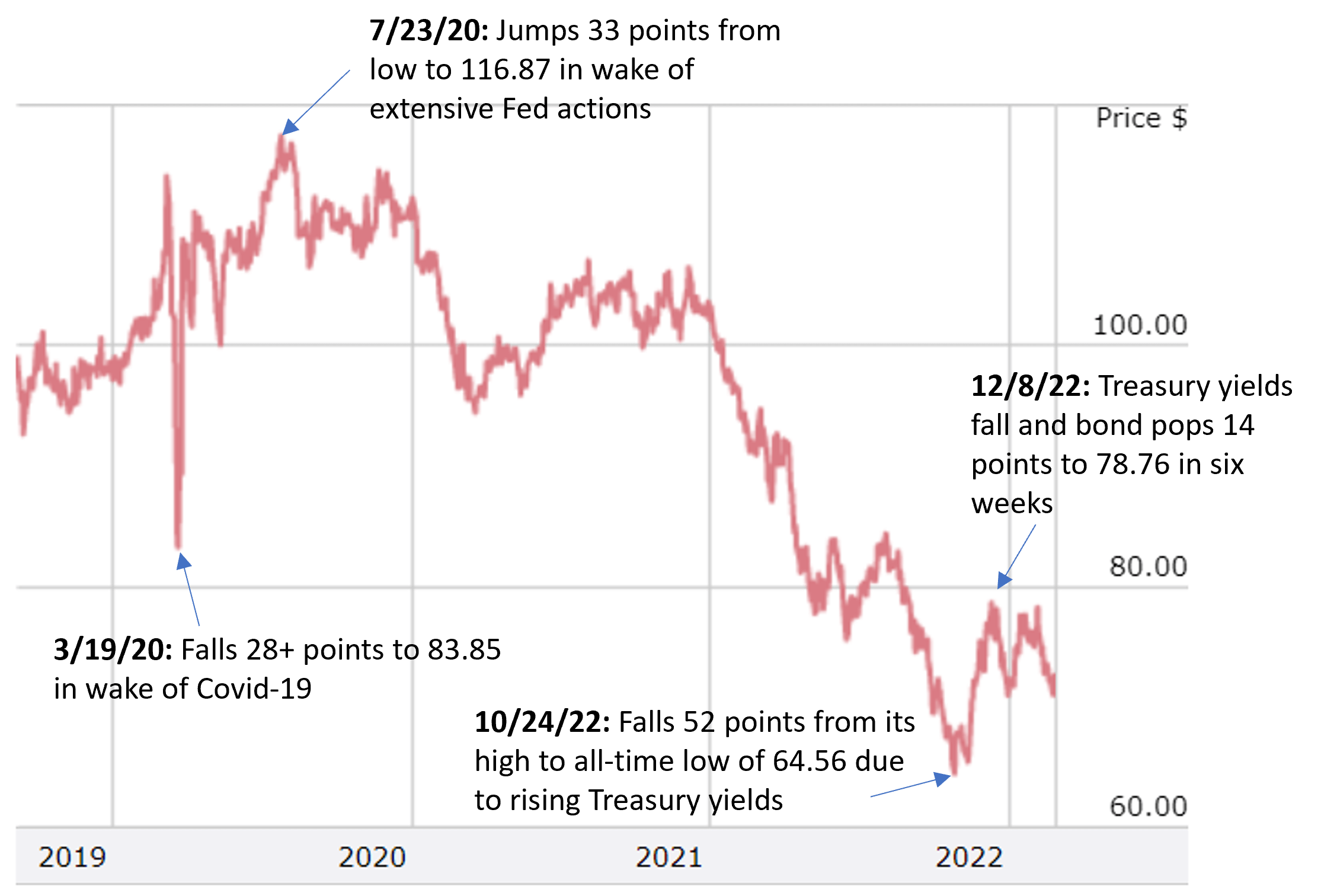
Source: FINRA market data
Of course, different corporate bonds pose different levels of risk, and there are
bonds that can fall in price and have significant risk of never returning back to par value. It can,
therefore, often be a better risk-reward opportunity to take advantage of volatility in bonds of higher credit
quality (like an Apple bond or similar), as permanent capital loss is generally not in the cards for such
bonds.
Investors can take advantage of price volatility in high yield bonds; however, more
diligence is needed. Sometimes, a bond price can fall 30+ points due to a corporate bond rating
downgrade. These can, at times, be opportunities resulting from a trigger-happy ratings analyst; however,
they do often pose a higher degree of risk than capitalizing on volatility by bonds issued by companies such as
Apple.
Recommendation 3: Do
Consider What's in Your Non-Bond
Portfolio
An important factor impacting the recommendations BondSavvy subscribers own is what other
investments are in the rest of their portfolios. This is one of the many reasons BondSavvy cannot be
prescriptive about which of our recommended bonds subscribers should own, as non-bond portfolios will vary, as will
investors' risk tolerance and investment objectives.
The case of two hypothetical investors, Reggie and Mary, illustrates our point:
Figure 4: Asset Allocation of Two Hypothetical Corporate Bond Investors
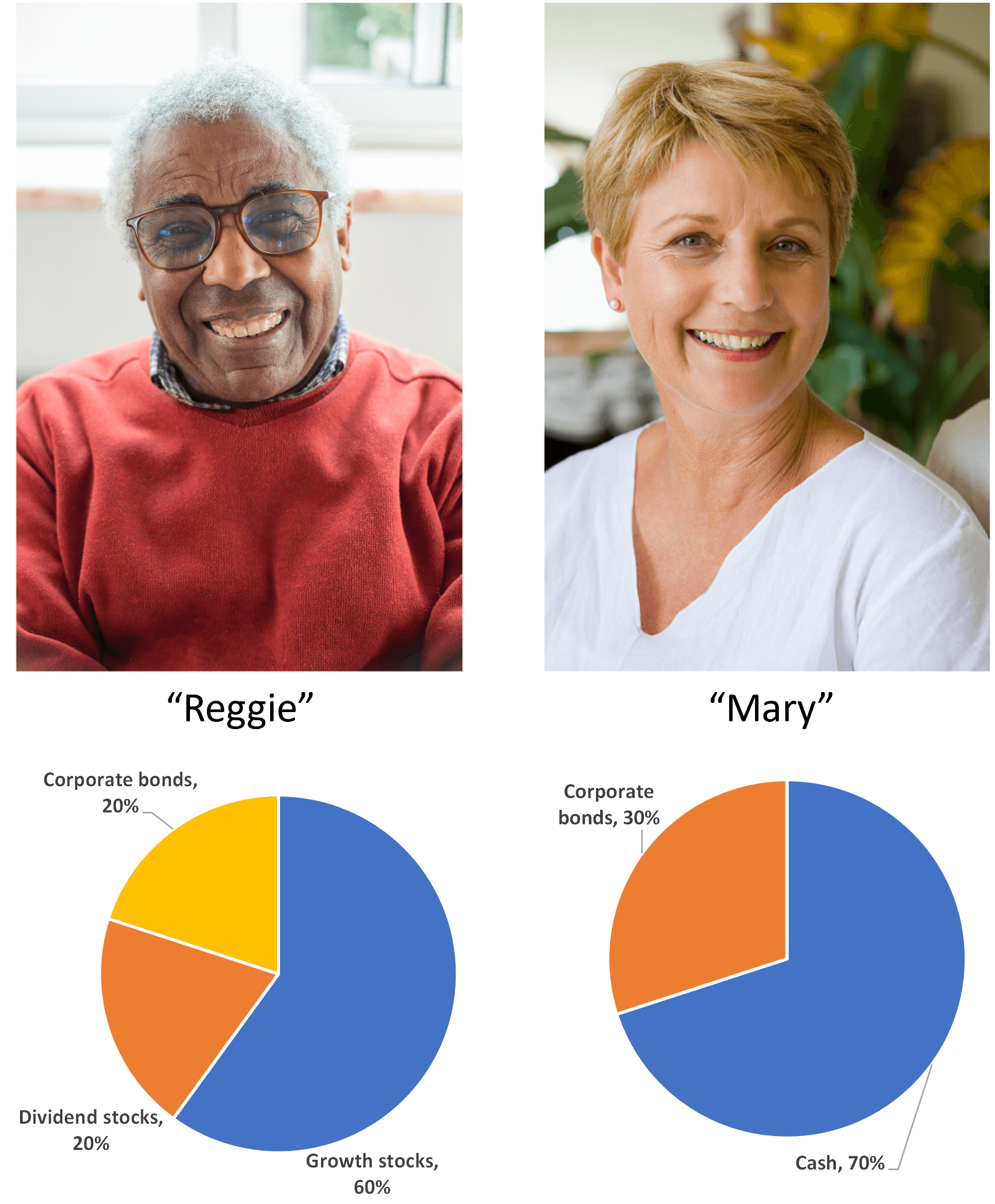
Both Reggie and Mary are regular visitors to BondSavvy's leading bond investing website. They both
recently decided to invest in individual corporate bonds to take advantage of their strong potential returns,
income, and safety relative to stocks. As shown in Figure 4 above, Mary is a more conservative investor than
Reggie, as 70% of her portfolio is held in cash. Since Mary holds such a large portion of her non-bond
portfolio in cash, she may, at some point, choose to be more aggressive with her corporate bond portfolio than
Reggie, who already has a healthy portion of his portfolio in higher risk investments.
That said, Mary will need to make the final call as to whether she is ready to accept the
volatility -- and potential loss of capital -- associated with higher-risk corporate bonds.
What industries are in your non-bond portfolio?
As of today, BondSavvy recommendations covered bonds issued
by companies in 16 different industry groups.
These industry groups included: manufacturing, defense, travel, natural
resources, agriculture, healthcare, homebuilding, technology,
chemicals, automotive, transportation, pay TV, retail,
communications, pharmaceuticals, and infrastructure. Many of these industry groups are broad, and
they could be further broken down.
In the case of our example in Figure 4, Reggie already owns growth and dividend stocks. Prior
to investing in BondSavvy's recommendations, he should evaluate the industry concentration in his stock portfolio to
ensure BondSavvy recommendations he buys do not overconcentrate his overall portfolio in a specific industry.
We further discuss the importance of industry diversification later in Recommendation 6 of this
fixed income blog post.
Recommendation 4: Do consider 'value'
available in the
marketplace when deciding how much to invest
Corporate bond investors can evaluate several metrics to
determine whether bonds available represent a good value. These include bond yields to maturity
(YTM), price relative to par value, and credit spread. Since these metrics do not consider issuing company
financials, they are meant to provide an initial assessment of value. After evaluating these factors, we can
dig into
issuing company financials.
In Recommendation 7, we show historical bond price charts for three oil & gas companies.
These charts show how the three bond prices moved as a percentage of par value.
In this Section 4, we will focus on how investors can use movements in bond YTMs and in credit
spreads to assess a corporate bond's value. This will just provide a pre-financial-analysis view of value in
the market. Prior to making new bond recommendations, BondSavvy completes its fixed
income investment analysis to determine whether a bond is a good value and whether it becomes a new
recommended bond.
Assessing Value Based on US Treasury YTMs
Since corporate bonds, especially investment grade corporate bonds, can be heavily impacted by US
Treasury yields, investors must evaluate the level of US Treasury YTMs when making new investments. Figure 5
shows historical YTMs for the two, ten, and thirty-year US Treasurys. It also shows the effective federal
funds rate.
As shown, 10- and 30-year US Treasury yields had been trending down from 2008 until 2021 before
shooting up in 2022, as the US Federal Reserve aggressively raised the fed funds target rate. US Treasury
yields are volatile and up or down movements can switch quickly.
When most bond yields were super low in 2020 and 2021, finding value in corporate bonds was
difficult. In late 2022 and early 2023, with certain Treasury yields at heights not seen since 2007 and 2008,
there was a greater amount of value available in the market. The reason for this is that, with US Treasury
yields at these higher levels, there's an opportunity for these yields to fall and for certain bond prices,
including corporate bonds, to rise.
Figure 5: Historical US Treasury YTMs and Effective Fed Funds Rate -- Jan 2, 2007-Feb 24, 2023
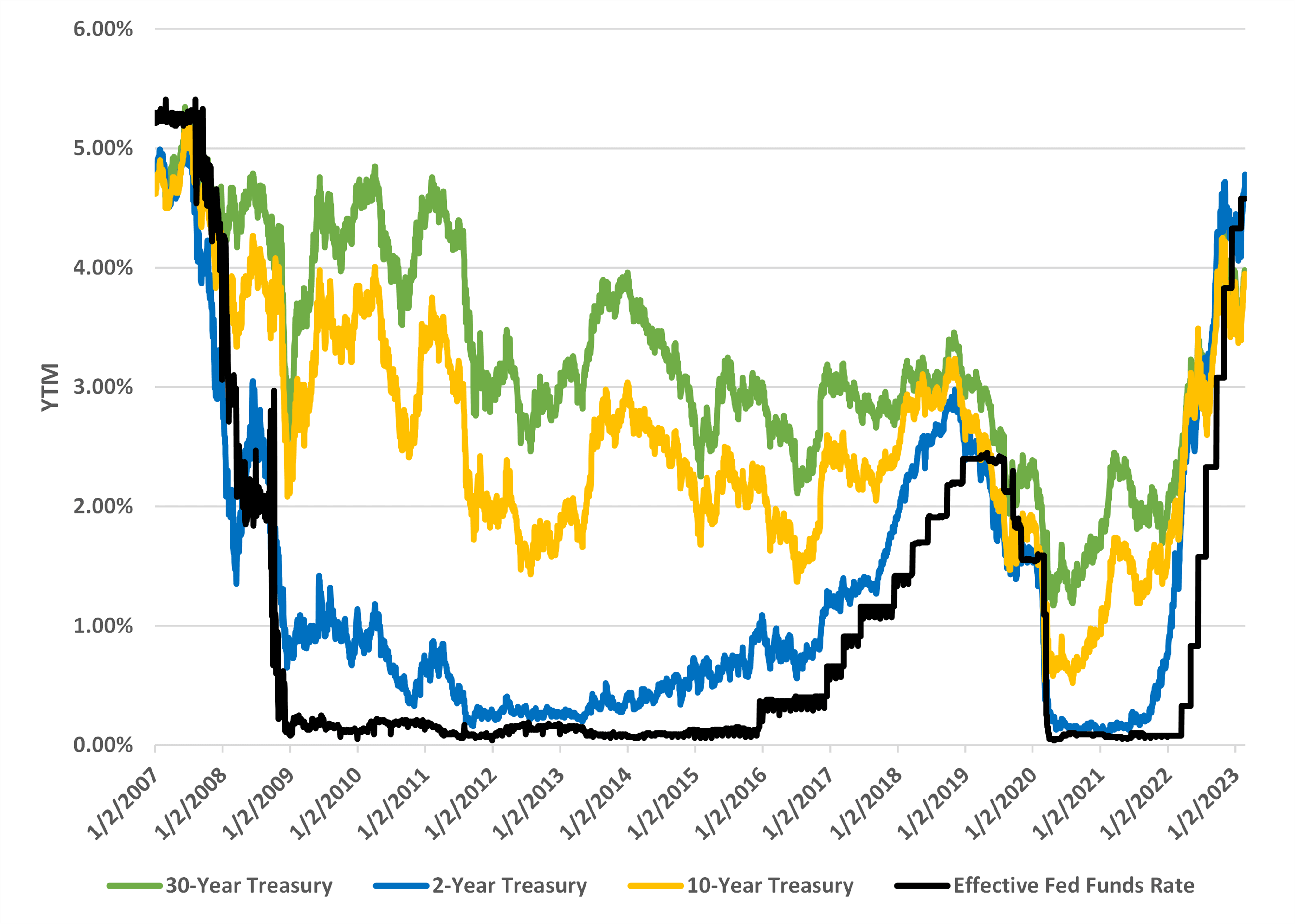
Sources: US Treasury Department and Federal Reserve Bank of New York.
When deciding how aggressively to make new corporate bond investments, it's important for investors to assess where
we are with respect to historical US Treasury yields.
Assessing Value Based on Corporate Bond Credit Spreads
When purchasing a new corporate bond on Fidelity.com, investors can see the corporate bond's credit spread, or the
difference in yield between the corporate bond and the US Treasury that has a similar maturity date. The
credit spread represents the extra compensation, or yield, investors receive for taking on credit risk that is
deemed higher than that of the US Treasury.
Figure 6 shows the historical credit spreads for two BondSavvy-recommended bonds: one rated
investment grade and the other a high yield corporate bond. It shows the credit spreads beginning the date we
made the initial recommendation and then on each date we updated the recommendation during The Super
Bondcast.
When we initially recommended the investment grade bond on May 31, 2019, it had a credit spread of
2.17%, which has been the high water mark of the bond's credit spread since the pick date. On December 14,
2022, the bond had a credit spread of 1.42%. Since this credit spread is materially lower than the pick date
credit spread, this bond had less credit-spread-related "upside" on December 14, 2022 than it did on the pick
date. When we say "credit-spread-related upside," we mean a credit spread's ability to fall, which could drive
a corporate bond's YTM lower and the bond's price higher.
Figure 6: Historical Credit Spreads for Two Bonds -- Pick Date to December 14, 2022
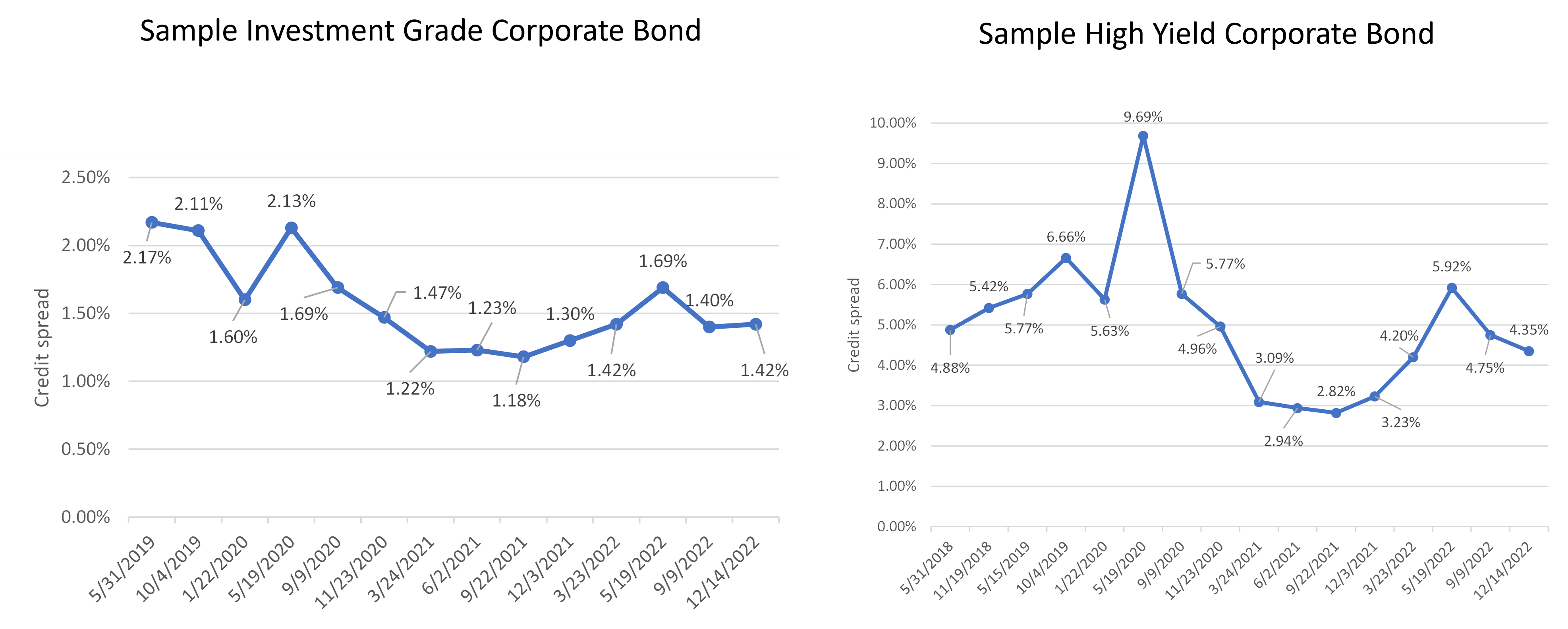
Source: Credit spreads from Fidelity.com. Charts created by BondSavvy
The range of credit spreads for the high yield bond is much wider than that of the investment grade
bond. While the high yield bond's credit spread on December 14, 2022 (4.35%) was only slightly lower than the
pick date credit spread of 4.88%, it went as high as 9.69% in mid-2020 in the wake of the Covid-19 crisis. One
of our mistakes was not selling this bond when its credit spread had fallen to below 3.00%, as it's not clear if and
when this bond's credit spread can return to such levels.
As noted above, evaluating US Treasury YTMs and corporate bond credit spreads is only the first
part of identifying value. When determining which bonds make our recommended list, we compare these bond
pricing metrics to issuing company
financial metrics such as leverage ratios, interest coverage ratios,
profitability growth, and all of the factors we consider in our corporate
bond research.
Recommendation 5: Don't Build Bond Ladders
We have written a separate blog post on “Why Bond Ladders Are Broken.” For the reasons we discuss
in that blog post, we believe an active approach focused on identifying bonds
with compelling values can drive higher total returns than bond ladder strategies. A big part of our fixed income
investing strategy is to sell bonds before maturity to lock in capital gains and maximize total
returns. As we summarize below, we
believe bond ladder strategies limit returns
and increase risk.
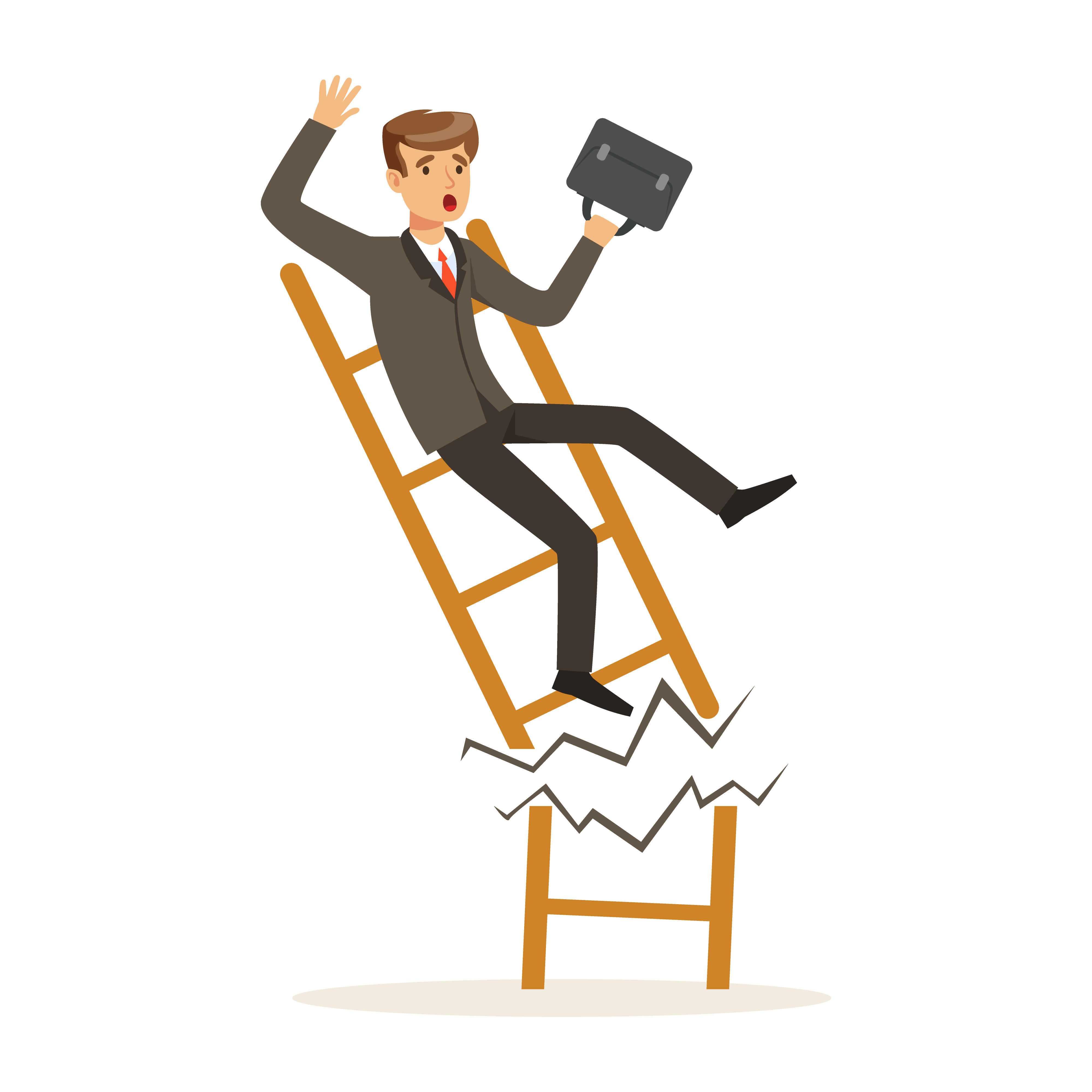
When BondSavvy recommends a new bond, we conduct comprehensive
corporate
bond research to assess a bond's risk and potential upside. This investment analysis identifies bonds
that can increase in price and achieve corporate bond returns that beat the leading bond funds and ETFs.
The initial recommendation is only when the work begins, as we then update each buy/sell/hold recommendation every
quarter based on the issuing company's financial performance and the price performance of each recommended bond.
We believe corporate bond ladders limit investment returns and increase risk due to the following
reasons:
- Bond ladders use a bond's maturity date as the primary
investment criterion
- Since bond ladders hold bonds to maturity, the highest return an investment can achieve is a bond's YTM on the
purchase date. Investors don't generally buy low and sell high with bond ladders
- At the creation of a bond ladder, there is a large initial investment of capital, which attempts to time the
market. This violates Recommendation 1 of How To Build a Bond Portfolio
- Bond ladders seek to return principal on a specific date rather than attempting to maximize performance over the
long term
- Bond laddering is a 'set it and forget it' strategy that lacks the rigor of our active investment
approach. Since the financial performance of the issuing companies is not regularly evaluated, we believe
bond ladder default risk is higher than that of an active bond investing approach
As bond yields rose in 2022, we began recommending short term investment grade corporate bonds, as their
yields finally reached compelling levels. We may decide to hold some of these bonds to maturity, as we
selected these bonds to lock in returns over two- to four-year periods. Holding bonds to maturity can make
sense in certain cases; however, we believe maintaining holding period flexibility is a big factor in maximizing
investment returns over the long term.
Recommendation 6: Do Diversify Across Industry Groups
On February 22, 2023, BondSavvy's 52 corporate bond
recommendations covered companies across 16 industry groups. One of the many benefits of owning individual
bonds vs. bond funds is that investors can create a portfolio that suits their
investment objectives. They can also
tailor it to reflect expertise they may have across different companies and
industry groups.

We discuss later the importance of owning bonds with bond ratings of both investment grade and
high yield. We recommend this since, generally speaking, investment grade and high yield bond prices are
driven by different factors, and we don't want our bond portfolio to be a one-trick pony.
The same can be said for owning bonds in different industries. It is difficult to predict,
year in and year out, which industries can outperform over the next several quarters. While BondSavvy's fixed income
investment strategy does consider how a bond issuer's industry can perform when we make a recommendation,
corporate financial performance is often not a straight line.
Owning bonds issued by companies of different industries helps mitigate risk and can position
investors to capitalize when a specific industry does particularly well. For example, through the date of this
fixed income blog post, BondSavvy had recommended seven bonds issued by companies in the oil & gas
industry. We began making these recommendations as the economy began recovering in the second half of
2020. While we have sold several of these oil & gas bonds, the ones we held during 2022 generally held
their value and delivered positive returns in the wake of one of the worst bond markets in history.
Recommendation 7: Do Own Both Investment Grade and High Yield
Corporate Bonds
While we are not big believers in corporate bond ratings,
investors must understand how bond ratings can impact the trading activity of
corporate bonds. Corporate bonds are not
a monolithic asset class, and different bonds will behave in different ways.
For example, investment grade corporate bonds, especially
those with a longer time to maturity, can be heavily impacted by changes in US Treasury
yields. High yield corporate bonds, on
the other hand, are impacted, to a greater extent, by the financial performance -
and perceived creditworthiness - of the issuing company.
We encourage BondSavvy subscribers to own both investment
grade and high yield bonds because we don't want all of our bond holdings to
behave in a similar way. We illustrate this point in Figure 7 by showing the bond price performance of three
bonds issued by oil & gas companies.
On January 12, 2022, we recommended BondSavvy subscribers purchase the Exterran Energy 8.125%
5/1/25 bond (CUSIP 30227KAE9) at a price of 94.71. Exterran was a natural gas processing and treatment
("midstream") provider based in Houston, TX. At the time of the recommendation, the Exterran bonds were rated
B3 / B by Moody's and S&P, had a YTM of 10.08% and a credit spread of 8.83% (or 883 basis
points).
Shortly after our recommendation, Canada-based Enerflex announced its acquisition of
Exterran. Since Enerflex had a higher bond rating than Exterran and the Exterran bonds would be assumed as
part of the transaction, the Exterran bonds traded up. Later, on October 21, 2022, the Exterran bonds were
called at a price of 102.03, which generated an investment return of 14.36% vs. a -13.51% return for the iShares HYG
high yield corporate bond ETF.
Figure 7: Corporate Bond Prices of Exterran Energy vs. Exxon Mobil Bonds -- January 12,
2022-October 21, 2022
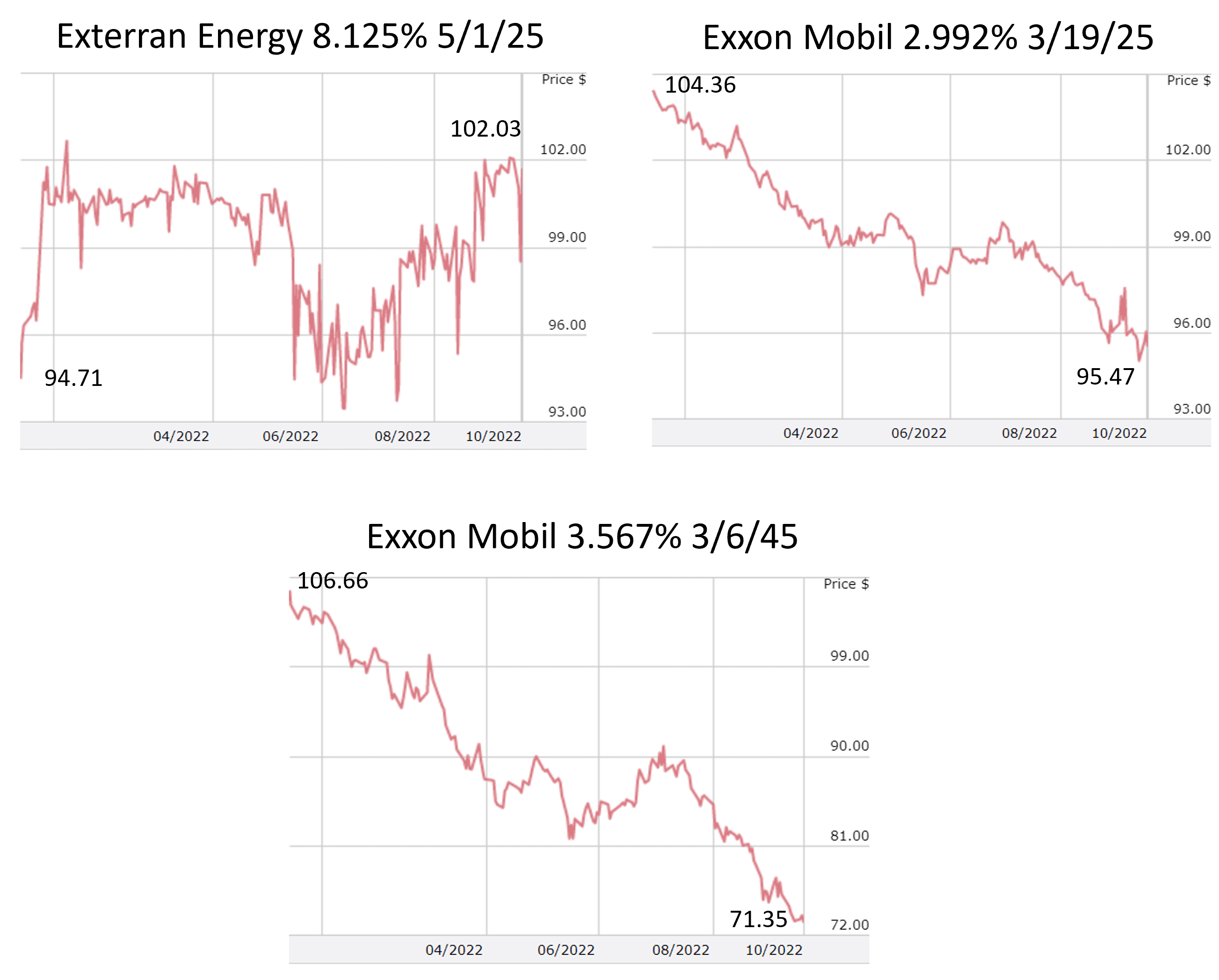
Source: FINRA market data.
As shown in Figure 7, both the Exxon Mobil '25 (CUSIP 30231GBH4) and Exxon Mobil '45 (CUSIP
30231GAN2) bonds performed poorly during the holding period of the Exterran bond, with the Exxon Mobil '25 bond
falling nine points and the Exxon Mobil '45 bond falling 35 points. In the case of Exxon Mobil bond investors,
they picked the right industry for 2022; however, since these bonds are rated investment grade (Aa2/AA-) and highly
sensitive to US Treasurys, 2022 was a year to forget.
Of course, not all years will be as bad as 2022 for bond investors. Moreover, investors in
2022 and early 2023 were able to purchase bonds issued by the world's most profitable companies at significant
discounts to par value.
Please read our corporate bond credit spreads blog post for a detailed discussion on what
causes corporate bond prices
to move and how this varies between investment grade and high yield corporate
bonds.
Recommendation 8: Do Diversify Across Maturity Dates
Investment grade corporate bonds are typically issued with maturity dates of 20 to 40 years compared to 5 to 10 years
for high yield corporate bonds. Owning a variety of both investment grade and high yield bonds will
take investors part of the way -- but not all the way -- to diversifying across maturity dates.
The number of bonds issued by companies can vary. Some companies may have over 100 bonds outstanding while
others may have fewer than a handful. Since high yield bond issuers are often smaller in size than investment
grade issuers, some high yield bond issuers may only have two or three bonds from which to select. As part of
our fixed income research, we then evaluate the trading activity of each bond and whether it has sufficient bid-ask
quotes to satisfy increases in trading volume driven from a new BondSavvy recommendation.
This is a circuitous way of saying that a high yield bond investor may not necessarily be able to
choose from a wide variety of maturity dates of a given high yield bond issuer.
As noted in this fixed income blog post, in 2022, BondSavvy began recommending short term corporate
bonds due to the compelling yields they were offering. This augmented our prior recommendations of long-dated
investment grade corporate bonds. Given how poorly long-dated investment grade corporate bonds performed
during 2022, we wanted to have a portion of short term bonds where we could count on a mid-single-digit return over
the next several years.
Such short term bond opportunities had not presented themselves until 2022. Given that we
don't want all the bonds in a corporate bond portfolio to behave in a similar way, it's important for investors to
take advantage of maturity-diversification opportunities when they can.
A note on Fallen Angel bonds
A bond is said to be a "Fallen Angel" when its corporate bond rating is downgraded from investment
grade to below investment grade. Since Fallen Angels were initially issued with an investment grade rating,
such bonds generally have certain characteristics of investment grade bonds such as longer maturity dates. It
is, therefore, often more possible for investors to find a wider variety of maturity dates with Fallen Angels than
it is with bonds rated below investment grade on the date of issuance.
Recommendation 9: Don't Feel Compelled to Buy Bonds in Large
Quantities
Your last name does not have to be Rockefeller to invest in individual corporate bonds. By investing in bonds
online, individual investors can transact in bond trade sizes as few as two bonds, or $2,000 in par value of bonds. Since investors can purchase
bonds in smaller quantities, they can build positions over time rather than feeling compelled to purchase a large
quantity in one transaction.
Companies such as Fidelity, E*TRADE, Charles Schwab,
Interactive Brokers, Tradeweb, Intercontinental Exchange, and others have
made investing in individual corporate bonds fair for investors. These companies have built online trading
platforms that aggregate corporate bond bid-ask quotes that retail brokerages display to their individual investor
clients. Investors can click on live bond quotes and execute trades within seconds.
While quoting levels can vary by bond and be impacted by market conditions, individual corporate
bonds often have at least six bid and offer quotes. This level of competition drives narrow bid-ask spreads
and high-quality trade execution for individual investors.
Figure 8 shows the depth of book for the Microsoft 2.700% 2/12/25 bond (CUSIP 594918BB9). The
"depth of book" shows both bid and ask quotes provided by dealers to facilitate corporate bond trading
activity. We discuss key takeaways from this table below Figure 8.
Figure 8: Depth of Book for Microsoft 2.70% '25 Bond on February 24, 2023
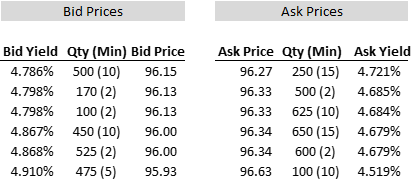
Takeaway 1 -- Minimum quantities of 2 to 15 bonds
The minimum quantity associated with each bid or ask quote is the number in parentheses in Figure
8. While they can vary slightly, minimum quantities typically available when investing in
corporate bonds online are 2 to 10 bonds. For the Microsoft 2.70% '25 bond, however, minimum
quantities were 2 to 15 bonds on February 24, 2023.
On the ask side (the price at which investors purchase bonds), the minimum quantity for the
"top-of-book" (or best) price of 96.27 was 15 bonds. For investors seeking to purchase a quantity of 2 to 14
bonds, they would need to execute at the slightly worse ask price of 96.33, a price that had a minimum quantity of
two bonds.
While it can be helpful to own corporate bonds in larger quantities, it may or may not affect the
price at which you execute your trade. As shown under the bid prices in Figure 8, an investor looking to sell
five bonds -- rather than 10 -- could have sold the bonds at 96.13, a smidge lower than the 96.15 top-of-book bid
price.
Since investing in bonds over time is central to our approach on "How To Build a Bond Portfolio,"
investors can build a position over time to limit timing risk or to take advantage of bond prices that
have fallen. For example, investors who had trepidation about the Federal Reserve raising interest rates in
2022, could have built a 25-bond position in this Microsoft bond over time rather than buying all 25 bonds at once.
Takeaway 2 -- Narrow bid-ask spread
Many investors are surprised as to how competitive corporate bond quotes are for individual
investors. As shown in Figure 8, the bid-ask spread for this Microsoft bond was 0.12 points (the difference
between the 96.15 and 96.27 top-of-book bid-ask quotes). On a YTM basis, the bid-ask spread was 6.5 basis
points (or 0.065 percentage points). When buying bonds online at brokerages such as Fidelity.com and E*TRADE,
bond investors can compare these live quotes to corporate bond trades reported to FINRA's TRACE reporting system.
The notion that individual investors "get ripped off" when trading individual bonds is far from the
case. While bid-ask spreads and the number of live quotes can vary, individual investors generally benefit
from robust levels of bond quotes and easy-to-use online brokerages that offer fast and efficient trade execution.
Recommendation 10: Do acknowledge that corporate bonds are not cash investments
Since company bonds are senior to a company's common stock, some investors treat corporate bonds as
if they are as good as cash. They are not. As shown in this fixed income blog post, corporate bond
prices can be volatile -- especially high yield corporate bonds and long-dated investment grade corporate
bonds.
There are some bonds, such as short-term bonds (1 to 3 years) of the highest-credit-quality issuers
that can be a good place to park cash; however, investors needing cash in one year should not invest
this amount in a three-year bond, even if it's a AAA-rated entity such as Microsoft.
With US Treasury yields rising during 2022, there were, finally, short term investment grade corporate bonds with
compelling yields. While this resulted in BondSavvy recommending such short term bonds for the first time,
investors must know that even these bond prices can fluctuate, albeit generally much less than high yield and
long-dated investment grade corporate bonds.
BondSavvy's Role in Building a Bond Portfolio
We founded BondSavvy to empower the individual investor. We didn't believe bond investors
were well served with opaque, underperforming bond funds. In addition, since corporate bond ratings don't
speak to whether a bond is a good investment, we felt bond investors deserved an independent analysis that
identified bonds that could outperform the leading bond funds and ETFs.
While many advancements have been made to make buying bonds
online efficient, before BondSavvy, individual investors still have to sift through 9,000 available
corporate bonds. BondSavvy changed this in September 2017, when it presented its first set of corporate bond
recommendations. Each quarter, we present between four to six new corporate bond recommendations during The
Bondcast, an exclusive webcast with subscriber Q&A. We then update all of our bond recommendations
each quarter based on our issuing companies' financial performance and the price performance of each bond.
Our goal is to make bond investing easy and more profitable for individual investors.
Click the "Get Started" button to learn about BondSavvy's subscription options or the "Watch Free
Sample" button to watch two free editions of The Bondcast. Let's get BondSavvy!
Get Started
Watch Free Sample